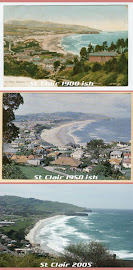
Time heals all wounds, nature is taking its' course in replenishing the sand at ocean beach.
Cam-Era – St Clair A
Cam-Era – St Clair B

Updated every 30 minutes.
from NIWA website
Ocean Beach is a 3 km long sandy bay in south Dunedin running from the St. Clair headland in the west to Lawyers Head in the east. The beach, located just 4 km from the centre of Dunedin city, is the main recreational beach in the region, being popular for surfing, swimming, and walking. At St. Clair, the Esplanade is popular with visitors for the numerous restaurants and cafes, while in the centre and eastern end of the bay the former back dune environment has been developed into sports fields and golf links.
The beach faces due south, and is exposed to the dominant south westerly winds blowing off the Pacific Ocean and frequent high energy southerly storm events. Sand is transported to Ocean Beach by a prevailing southerly current and the dominant southwest swell conditions.
In pre-European time, the Ocean Beach area was characterised by small sand deposits at the western end, increasingly large sandhills to the east, and a hinterland dominated by a lagoon and swamps. As early as 1876 sand was being removed from the dune to fill the low-lying hinterland to meet the growing needs for housing in the developing city. There has also been a long history of coastal erosion issues at Ocean Beach: breaching of the dunes producing sea flooding in the low-lying hinterland suburbs was reported in the 1880s and 1890s; a seawall has been present at St. Clair since 1888; and dune stabilization using brush fences and marram plantings was first started in the 1890s. These erosion issues have continued at periodic times over the last 100 years, with episodes of rapid dune erosion being interspersed with periods of stability and dune growth. The last major erosion episode occurred in 2007, when up to 20 m of dune retreat was experienced, and an estimated 200,000 m3 of sand was removed from the dunes and beach. As a result of this erosion, the DCC were forced to undertake emergency works to protect both public and private assets.
As a consequence of the 2007 erosion episode, the DCC have embarked on an investigations programme to better quantify the nature and magnitude of the coastal processes operating within Ocean Beach, which will allow better decisions on future beach management to be made. The Cam-Era project is part of this investigations programme, producing much needed real time information on wave conditions, movements of rip currents, and beach responses. Without the Cam-Era site, this type of data would only be available from irregular visual observations, photographs, and beach surveys, none of which are able to supply a continuous picture of coastal processes and beach responses.
Favourable weather conditions over the summer to date have meant the volume of sand on the beach continues to rise steadily.
In the meantime, focus group meetings with key stakeholders continued during December and January, with the final group of meetings with these stakeholders scheduled for mid- February. Ecological studies (fauna and flora) of the area has now been completed.
That report on the area's ecology will be the first of a number of comprehensive reports to be received that will eventually provide the information and data needed for the draft plan for Ocean Beach.
